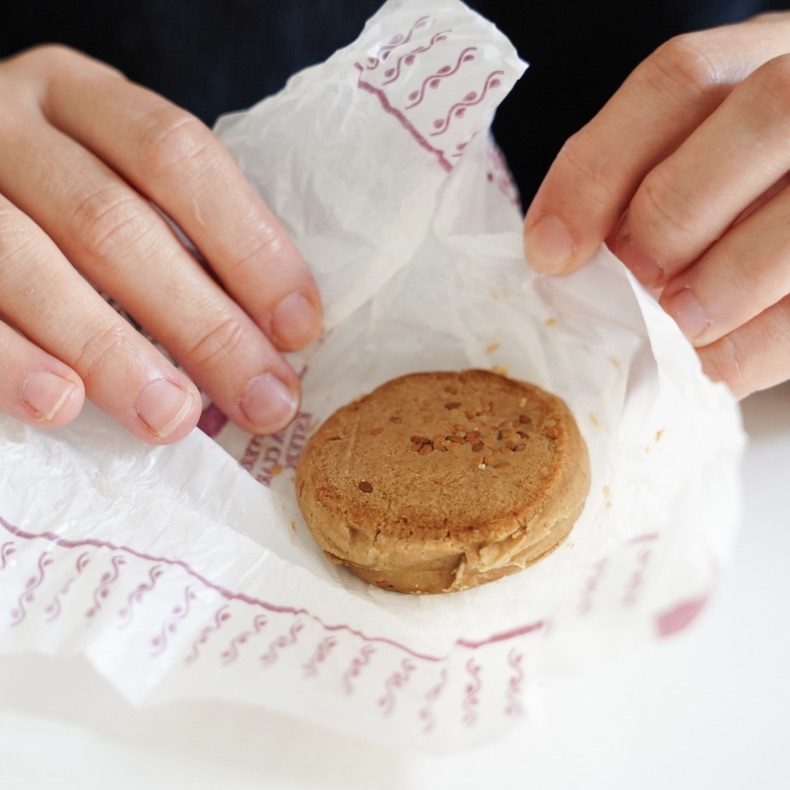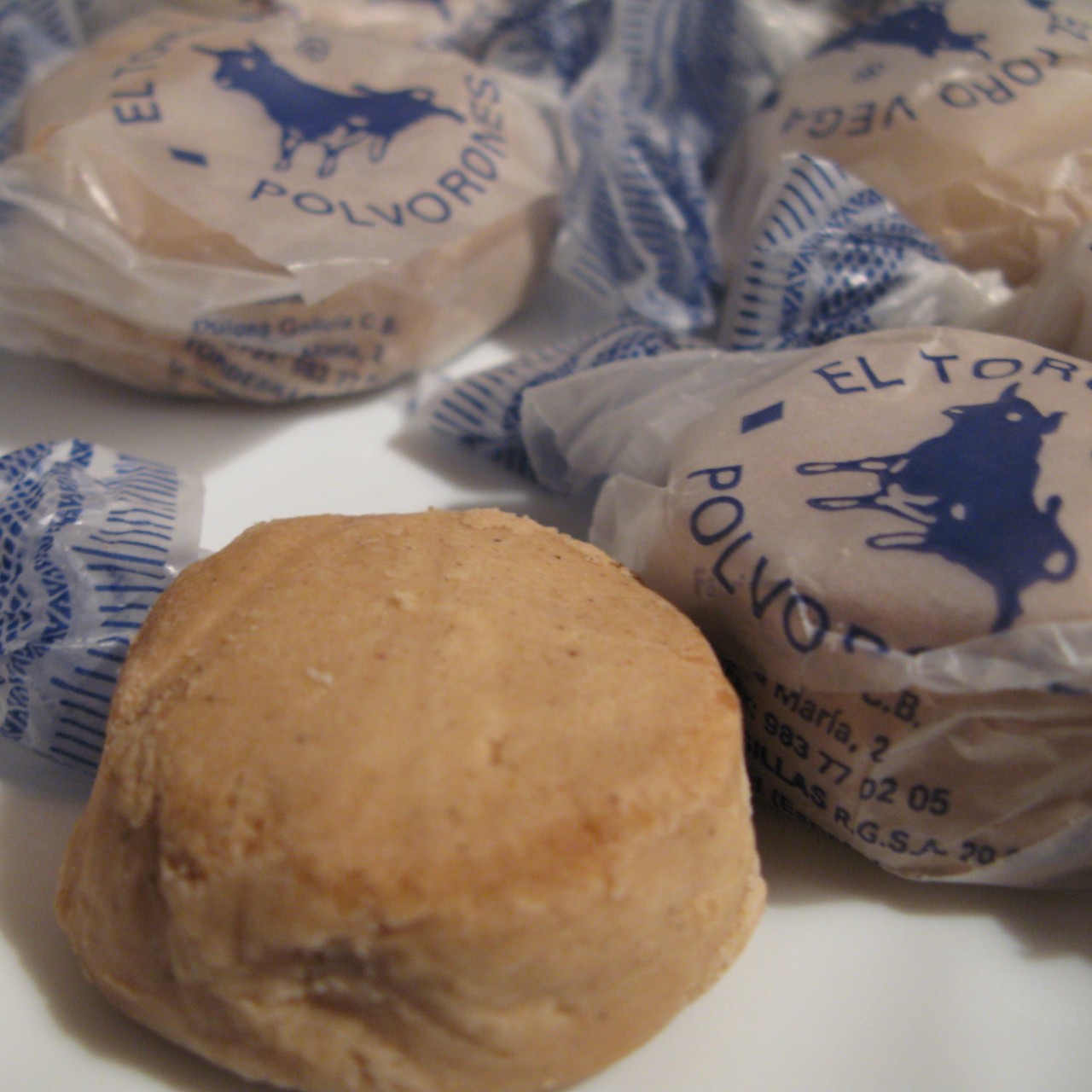by Blanca Valencia - @blancsvalencia
.png.transform/rendition-xs/image_image%20(1).png)

by Blanca Valencia - @blancsvalencia
The almond is the base of these traditional sweets: unwrapping them and eating them as they crumble is a whole ritual of this season
They always return, faithful to their appointment, with the start of the festive season: the fatter and circular mantecado and its more subdued oblong cousin, the almond-scented crumbly polvorón. Because they both originated in Andalusia and contain pork fat, the two are often confused. Traditionally, polvorones, which many continue to consider as a type of mantecado, contain almonds and are dusted with icing sugar, while mantecados are round with cinnamon or sesame sprinkled on top. Using a higher proportion of fat gives mantecados a more compact texture, while polvorones, which are baked for a shorter time, crumble more easily into powder.
A Nochebuena or Christmas Eve feast feels incomplete without the symbolic finale of dusty crumbs from these treats spilling out of their colourful silk paper or cellophane wrappers. While holiday sweets like turrón and Roscón de Reyes are meant for sharing, the individually packaged-polvorón or mantecado offers a more solitary pleasure. Eating a mantecado is a sensory ritual: the soft crinkle of paper as you unwrap it, the sandy texture of the sweet that miraculously holds together until the first bite and the final melt-in-your-mouth harmony of bold spices such as cinnamon, clove and aniseed flavoured with coconut, lemon, cacao, or hazelnut. Both are delicate confections, requiring gentle handling, with a bit of crumbling almost inevitable—especially with the polvorón.

Original from Andalusia
As with any popular and lucrative food product, their origin is the subject of lively debate.The exact origin of these confections is difficult to pin down but apart from the pork fat the cookies don’t feel out of place in the courts of mediaeval Muslim Andalusia or Al-Andalus with their liberal use of spices, sugar and almonds. After the expulsion of the Muslims who had been in Spain for 800 years, Catholic convents spread rapidly across Andalusia (especially in Seville) where nuns developed countless sweet recipes. The use of lard was both a remnant of the annual Matanza (pig slaughtering) and added a distinctly Christian touch in this time of religious turmoil, forced conversions and expulsions. The contemporary gastronomic rivalry centres on two towns—Estepa in Seville and Antequera in Málaga—each claiming to be their birthplace.
The Protected Geographical Indications (PGI) Mantecados de Estepa and Polvorones de Estepa holds the only European quality designations of their kind in Spain, granted in 2011 for mantecados and 2016 for polvorones. This town of about 12,000 inhabitants, traditionally a stopping point between Málaga and Seville, produces a staggering 85% of the confections in the market, with nineteen PGI-certified factories in Estepa that produce over 15 million kilos annually. The oldest, La Colchona, still exclusively uses traditional wood ovens fueled by olive and holm oak. One of the largest and most well-known brands La Estepeña maintains their traditional ovens, a tourist attraction in their much-visited museum. According to José María Férnandez, the president of the PGI, the lard for making Estepa confections comes solely from Ibérico pigs, a uniquely Spanish pig breed that roams the Dehesa or natural parklands. This pork fat contains over fifty percent oleic acid—the same found in olives—which helps reduce cholesterol. The almonds, the prized Marcona variety, are distinctly sweet and moist and very much Spanish. Such is the influence of mantecados and polvorones here that that town’s streets and avenues even bear the names of its ingredients: Azúcar (sugar), Canela (cinnamon), Ajonjolí (sesame) and yes, there is an Avenida (avenue) del Mantecado! The process for making the confections kicks off each August, explains Férnandez, when the town’s factories grind Sri Lankan cinnamon sticks over a metre and a half long, perfuming the air in anticipation.

Estepa’s rival, the nearby town of Antequera, claims that its mantecados were first. Estepa’s mantecados are said to date back to 1780, to the cloistered nuns of the Convent of Santa Clara, where these confections were crafted. However, Antequera proposes that their mantecados existed as a low-cost popular sweet in the sixteenth century, two hundred years before, due to an oversupply of wheat and pork fat. In Antequera, the range of producers goes from the small convent based makers like Convento de Belén, Convento de las Descalzas and Convento de la Encarnación to Sancho Melero, a company with over 70 years in operation and 180 year-round permanent workers.
However, according to gastronomic journalist Ana Vega Pérez de Arlucea the earliest recorded recipe for mantecados comes neither from Estepa nor Antequera, but from Morón de la Frontera, Seville, in a 1740 manuscript by a woman named Rosa María Calvillo. In fact, the Estepa and Antequera dispute of who made the first cookie overshadows the fact that behind these confections lies a history of female entrepreneurship and labour, for no matter where the first mantecado or polvorón was made, there is no doubt that it was made by a woman. After all, these delicacies began life as convent sweets, invented by economically shrewd nuns in the convents which were then rapidly spreading through Andalusia. Anthropologist and researcher Dr. Anastasia Téllez Infantes has explored the further impact of this industry on the development of Estepa’s town culture and the role of mantecaeras, the women who form the backbone of the industry and are 85% percent of the workforce. Téllez details the unique vocabulary of the industry with words such as “resecao,” which describes the key step of drying the flour—a technique pioneered by Micaela Ruiz Téllez. Nicknamed La Colchona, Tellez was the first entrepreneur of this industry, establishing her business in 1850.
Outside of Seville and Malaga other famous brands such as El Toro based in Valladolid and Felipe II, in Vitoria win taste awards and have a patent for their product. Meanwhile, Aromas de Medina from Medina Sidonia in Cádiz are sold to American audiences at Mercado Little Spain and in La Tienda.
In fact, exports play a significant role in spreading polvorones and mantecados around the world. According to data from the Regulatory Council of the PGI this year, in addition to being sold in all European Union countries, Estepa's mantecados are expected to enter various markets in Mexico, the Dominican Republic, Brazil, and Argentina, as well as having established customers in countries like Japan and the United Arab Emirates.

A new life beyond the Festive Season
Mantecados and polvorones are pushing past their traditional role as Christmas treats, with trends transforming them into ice creams, aperitifs and milkshakes. Restaurants, too, are giving them new life by using them as dessert bases, while winemakers pair them with iconic Andalusian wines. In 2022, Pepe Ferrer, Ambassador for the Gastronomy of Jerez-Xérès-Sherry y Manzanilla Sanlúcar de Barrameda DO, crafted intriguing pairings that matched the confections with “aliños” or seasonings like curry, sherry vinegar, and foie gras, to the region’s wines, showcasing how versatile these traditional confections can be. In recent years, innovators like Sancho Melero have also nodded to Northern tastes; in 2020, they introduced a mantecado variety made with 20% butter and have a popular miniature line under the brand Mantequera.
Driven by Muslim immigration and evolving dietary preferences, halal and vegan varieties of mantecados have gained popularity. Producers now supply larger quantities where they substitute lard with extra virgin olive oil. In Estepa they use extra virgin olive oil from the Estepa Olive Oil Protected Denomination of Origin (PDO), which cultivates Hojiblanca, Manzanilla, Arbequina, Picual, and Lechín olives: bringing the sweet back to its possible mediaeval Muslim version.